This Lychee wine recipe is easy to make, and produces a unique and delicious dessert wine - basically like a lychee flavoured ice wine!

A few years ago - a decade ago, maybe? - I happened across a supplier of fruit purees, in the context of cake supplies. I don’t remember who they were, just that they had all kinds of cool stuff. Pomegranate, fig... even lychee.
We were very much in our “Oh, can we ferment THAT?” stage of wine making, so we played with all the things.
Some of the wines were decent. A bit of back sweetening brought them up to really decent wines.
One of the wines was straight up disgusting. I think it was the one from the fig puree. All I remember is that the finished wine tasted like TOMATOES. Huh?
The lychee one, though? *Freaking amazing*.

It had turned out like an ice wine. Vaguely syruppy, very sweet... a beautiful dessert wine. Like drinking candy, in a good way.
We decided that we would have to make another batch, using something other than a super specialized product that came from one specific supplier, so we played around a bit.
Several years later, I’m happy to finally be able to present our refined lychee wine recipe!
This final version makes use of lychees in a much more convenient, widely available form: Canned.
Unlike most of our wine recipes, it’s absolutely not season dependant, and doesn’t require you to sort through fruit to pick out anything that’s not awesome.
Just dump the cans in a food processor, blitz it a bit to chop them up, and you’re good to go!
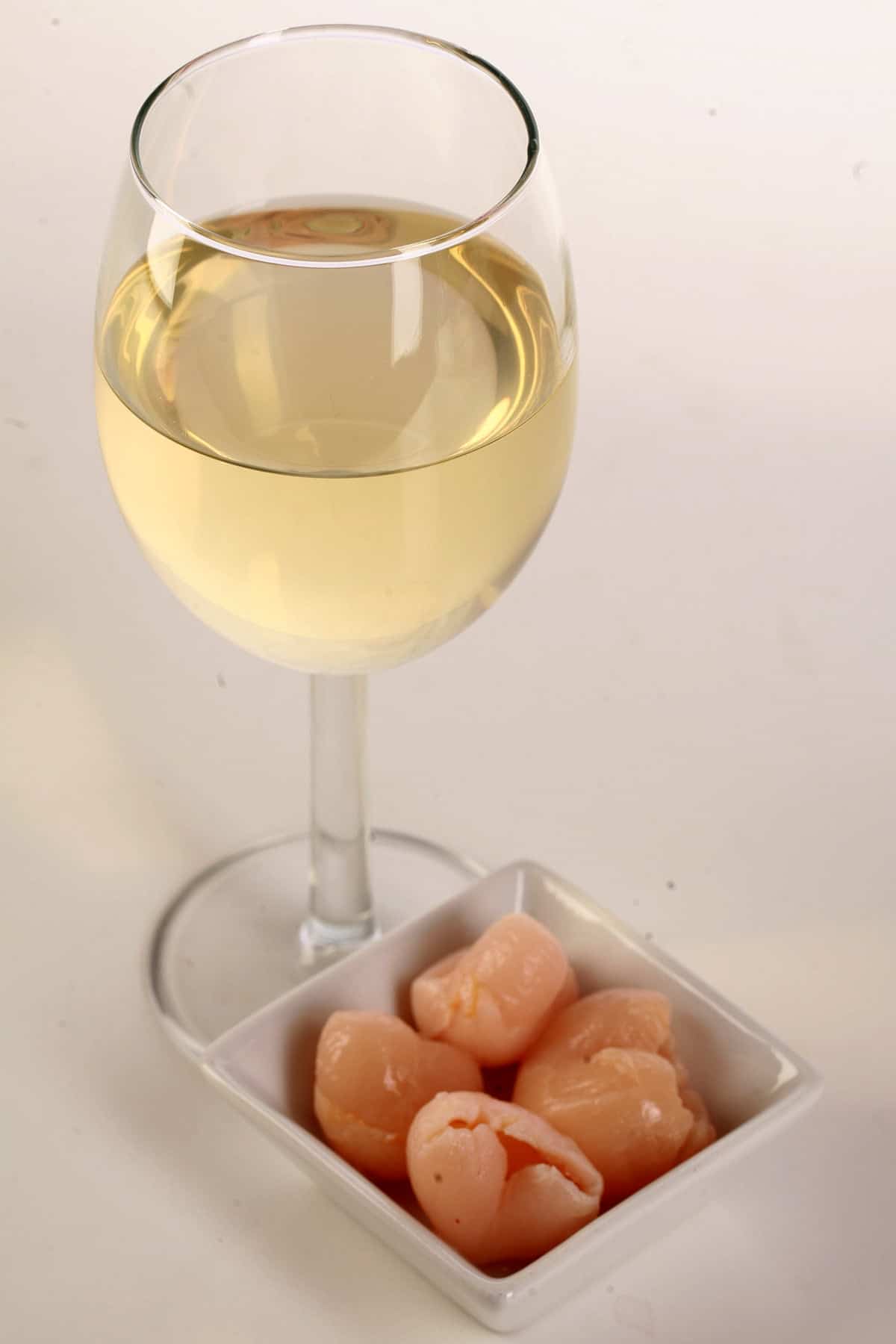
How to Make Lychee Wine
If you haven't attempted making wine before, don't be intimidated! Check out our primer to home brewing:
- Wine Making At Home, Part 1: Why?
- Wine Making at Home, Part 2: Equipment to Get Started
- Wine Making at Home, Part 3: The Brewing Process.
- Wine Making at Home, Part 4: How to Stabilize and Back Sweeten Wine
Just a small handful of entries, and you'll be good to go!
Lychee Wine Ingredients
This wine recipe requires only a few ingredients to make - super simple! Here is some information about those base ingredients that you may find helpful.
Lychees

While Lychees can be hard to come by, sometimes expensive - especially in the quantity needed for wine - and fussy to work with, canned lychees are NOT.
So, after experimenting with a few different ways of making wine from lycheese, we settled on the canned lychee version as being the best - all things considered.
When photographing the process for this blog, we used Cock Brand Lychees in Syrup, which worked really well and made a delicious wine.
However, there are several brands out there, and what you have available to you is going to vary wildly based on where you are. Larger grocery stores should carry canned lychee, but if not ... it’s a pretty sure bet to find them in Asian grocery stores.
Net weights may vary slightly, it’s totally ok to round up or down a bit when making this. The one thing you MUST keep in mind, though:
Be absolutely sure that your lychees don’t have preservatives in them.
Acid, acid regulator, anything like that - totally ok. If you see anything like potassium sorbate in it, that can of lychees will NOT ferment.
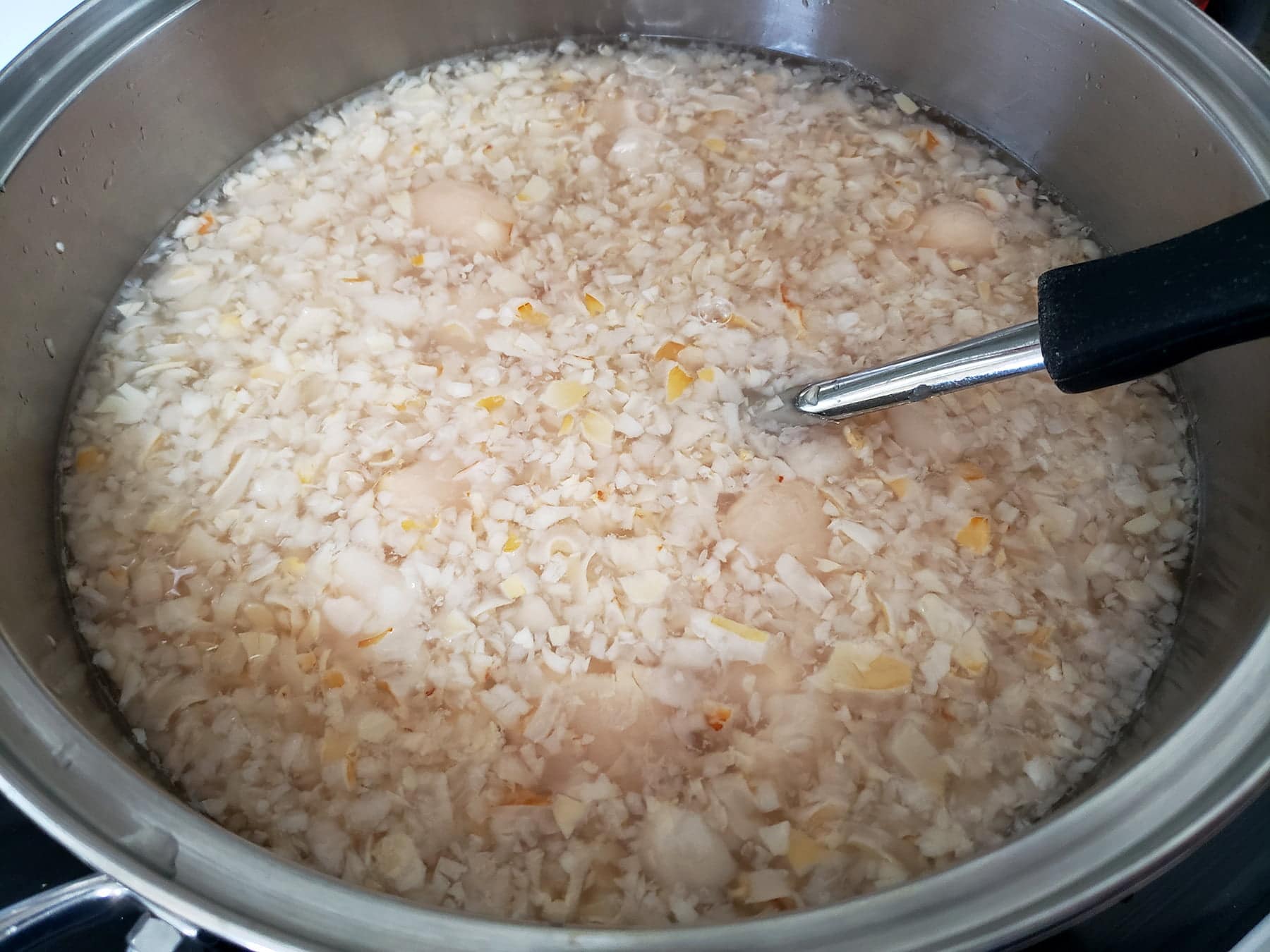
Chopped canned lychees,, early in the wine making process.
Sugar
While sugar is technically optional when making wine, NOT adding any sugar will result in an INCREDIBLY dry wine.
When you’re making wine from lychees - much like with any other light coloured, non-grape fruit - you’ll want it to have at least some residual sweetness to it, or it just won’t taste like much. The sugar helps to bring out the Lychee flavour!
Sugar is an important part of wine making, and there are a few aspects of sugar to keep in mind:
Type of Sugar
In terms of type of sugar, we prefer to use plain white granulated sugar for this wine. Brown sugar would definitely overwhelm the delicate lychee flavour.
How to Make Lychee Mead
If you’d like to make a mead rather than a wine, you can swap the sugar out for honey. You can use 4-5 lbs of honey for this.
A couple notes:
- I say “Lychee Mead”, as that’s what most people would understand... but mead with fruit is technically called “melomel”.
So, swapping sugar out in favour of honey would give you a lychee melomel. The more you know!
- When you’re using honey instead of sugar, you’re going to want to be careful in your choice of honey. Where white sugar is fairly neutral in flavour, honey can be aggressively flavoured.
I recommend picking something lightly coloured and lightly flavoured - a clover or orange blossom honey, for instance.
Something like a wildflower or buckwheat honey is likely to completely overwhelm the flavour from the lychees.

Alcohol Content
Aside from flavour, there’s the matter of alcohol content.
Your wine’s final ABV will vary wildly dependent on a few things: The initial sugar content of the lychees you use, how much sugar you add, and what kind of yeast you use (more on that in a bit)
Any amount of sugar will result in a higher alcohol content than making the same wine without sugar added. Sugar - both in the base wine itself, and from the added sugars - is what feeds the yeast, the yeast eats up the sugars and gives off alcohol as the byproduct of that process.
More sugar = more food = more alcohol... to a point, anyway. About that...

Yeast
The type of yeast you use will impact the alcohol content of the final product.
Yeast organisms don’t have an *unlimited* capacity to process sugar into alcohol. At some point, the environment they’re living in - the brewing wine - becomes too high in alcohol for the yeast to survive. They die off, the fermentation stops.
Different types of yeast have different tolerances for alcohol in the environment. That is, some yeast will be able to survive higher amounts of alcohol in the wine, so they’ll continue producing it longer than some other types.
Some types of yeast will bring you to something like an 8% ABV, while others will let things run wild until close to 20% ABV.
It’s good to know what you have in mind, when you choose your yeast.
If you want a sweet wine with a low-ish ABV - without having to back sweeten it (more on that in a bit) - choose a yeast with a lower tolerance for alcohol.
If you’re looking for a dry wine with a low ABV, choose a yeast with a lower tolerance for alcohol, and don’t use a ton of sugar.
If you want a sweet wine with a high ABV, use a bunch of sugar with a high-tolerance yeast... and be prepared to backsweeten it.
If you want a dry wine with a high ABV, use a fair amount of sugar and a high tolerance yeast.

Everything Else
Everything else in this recipe is technically optional, but contributes to it finishing as a well balanced wine. These ingredients include:
Acid Blend, Tannin - Balances and rounds out the flavours.
Pectic Enzyme - Breaks down fruit, especially as it relates to preventing “haze” from the pectins.
Yeast Nutrient - Gives a boost to the yeast.
Making Larger Batches of Wine
As a note, you can easily scale this wine recipe up - in fact, there's a function inside the recipe card itself to do the math for you!
One note, though: You don't need to multiply the yeast, but the software doesn't know that. We will use one pouch of yeast for anything from 1-5x batches, and then 1 pouch for every 5x batches beyond that.
As a related note: The recipe software is definitely geared towards cooking, not wine making. Therefore, you can pretty much ignore all of the info it gives you: The nutritional info is calculated on everything that goes into the wine.
It does not take into account how much sugar will be fermented out, how much volume is lost to racking, the fact that the fruit pulp is removed before the final product, etc.

Back Sweetening Your Homemade Lychee Wine
Sometimes - usually, even - you’ll find that the yeast went a bit too far with their smorgasbord, and you end up with a wine that’s not as sweet as you’d like it.
As previously mentioned, with lychee ... not sweet enough could mean it not tasting like anything!
... so that’s when you back sweeten it! You can read my How to Stabilize and Back Sweeten Wine post for information on how to back sweeten it.

More Home Brewing Recipes!
While you've got your current homebrew fermenting away, why not consider putting a batch of something else on, to occupy your wait time? Here are a few of my other wine, cider, and mead recipes:
Wine Recipes
Banana Wine Recipe
Blackberry Wine Recipe
Blackcurrant Wine Recipe
Blueberry Wine Recipe
Cherry Wine Recipe
Cranberry Clementine Christmas Wine Recipe
Cranberry Wine Recipe
Faux Lingonberry Wine
Mango Strawberry Wine Recipe
Mango Wine Recipe
Mint Wine Recipe
Lychee Wine Recipe
Partridgeberry Wine Recipe
Passionfruit Wine Recipe
Peach Wine Recipe
Stone Fruit Wine Recipe
Strawberry Wine Recipe
Ube Wine Recipe
Watermelon Wine Recipe
Mead Recipes
Black Cherry Mead Recipe
Blueberry-Clementine Mead Recipe
Blueberry Mead Recipe
Clementine Mead Recipe
Pumpkin Mead Recipe
Wildflower Mead Recipe
Cider & Miscellaneous Homebrew Recipes
Hard Apple Cider Recipe
Home Brew Hard Iced Tea Recipe
Maple Hard Apple Cider Recipe
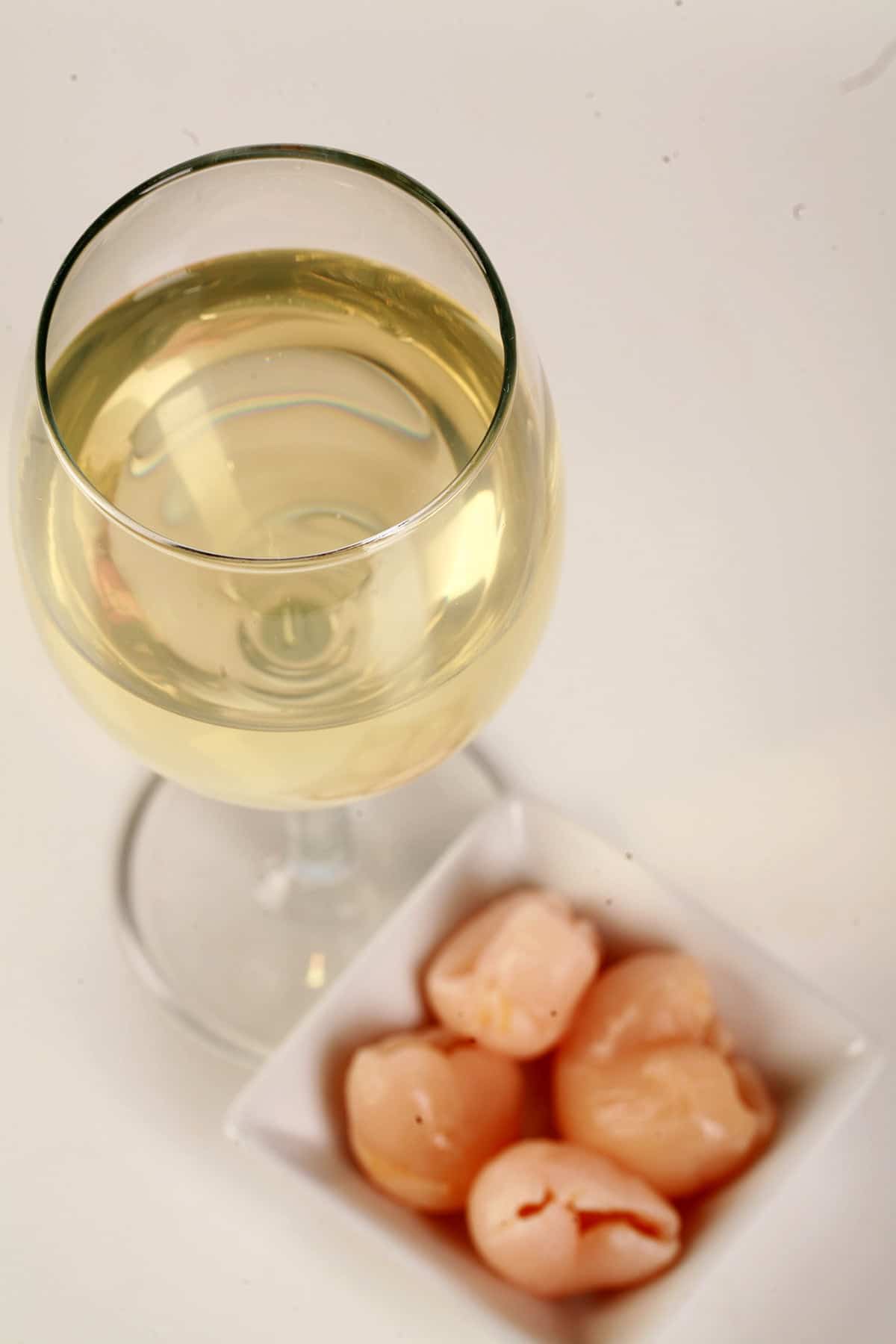
Share the Love!
Before you drink up, be sure to take some pics of your handiwork! If you post it to Bluesky, be sure to tag us - @CelebrationGen. We're also on Pinterest, so you can save all your favourite recipes to a board!
Also, be sure to subscribe to my free monthly email newsletter, so you never miss out on any of my nonsense.
Well, the published nonsense, anyway!
Anyway, on to that Lychee Wine Recipe!
Homemade Lychee Wine
Equipment
- Large pot
- Slotted Spoon
- Large wire strainer
- 2 gallon fermenter bucket and lid
- 1 air lock and stopper
- Long spoon / paddle
- 2 1 gallon carboys
- Siphon, siphon tubing.
Ingredients
- 4 Cans Lychee in Syrup
- 4 cups Granulated Sugar
- 12 cups Spring Water
- 1 teaspoon Acid Blend
- 1 teaspoon Yeast Nutrient
- ½ teaspoon Pectic Enzyme
- ¼ teaspoon Wine Tannin
- Red Star “Champagne” Brewing/Wine Yeast Or other brewing yeast of choice.
Instructions
- Pour canned lychees - fruit AND syrup - into a food processor or blender, blitz to chop. You may need to do this in batches.
- Combine lychees & syrup, sugar, and water in a large pot. Heat over medium until just before it starts boiling.
- Once mixture starts bubbling, turn the temp to low and simmer for 40 minutes. Think more “keep it warm”, than any kind of active simmer.
- While the pot is simmering, prepare your fermenter bucket: Wash and sanitize a 2 gallon plastic fermenter, lid, stopper, and air lock.
- Place acid blend, yeast nutrient, pectic enzyme, and tannin into the plastic fermenter. Affix the stopper to the lid of the fermenter, cover and set aside.
- Once the 40 is up, cover the pot, remove from heat, allow to cool.*
- Once cool, carefully pour wine into the fermenter.
- Affix air lock to lid, cover the bucket, and allow to fully cool over night. For the sake of consistency in readings - and therefore accuracy in ABV calculations - this should be done where you plan to let the wine ferment for the next few months - usually a basement.
- The next morning, check the Specific Gravity and write it down in your notes, along with the date (optional)
- Add yeast to the fermenter bucket, stir with a long, sanitized spoon. Affix the lid, allow to sit for 24 hours.
- The next day, check to make sure that the yeast has started fermenting - there should be bubbles in the airlock, and/or foam in the liquid. Put the lid back on, allow to ferment for one week.
- * It doesn’t have to be all the way to room temperature, just cool enough that if it splashes on you, it won’t hurt - that’s a good guideline!
- After a week or so, use your sanitized siphon setup to rack the must into a freshly sanitized carboy. Put the carboy somewhere cool (not cold!), and leave it alone for a month or so.
- Using sanitized equipment, rack the wine off the sediment, into a clean, freshly sanitized carboy. Cap with sanitized airlock, leave it alone for another 1 month.
- Rack one more time, leave it for another 2 months or so.
- When your wine has been racked a few times and shows NO more fermenting activity for a month or so (no bubbles in the airlock, no more sediment being produced, you can move on to back sweetening and bottling.
- Follow the instructions on your selected type of wine stabilizer to stop fermentation from restarting. For potassium sorbate, this needs to be done 2-3 days before bottling.
- Take a gravity reading if applicable, then back sweeten as desired, using sanitized equipment.
- Using sanitized equipment, rack the wine into clean, sanitized bottles. Cork.
Notes
Additionally, the listed value is for the entire recipe, NOT per serving.






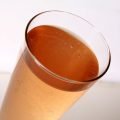



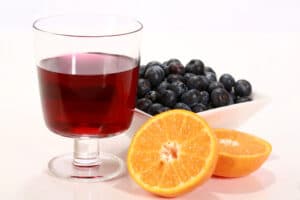
Ron
Should the lychee pulp be completely strained off when transferring from kettle to primary fermenter? Or should some pulp go along for the first round of fermenting? Thanks!
Marie Porter
Just pour the whole thing into the bucket. The pulp will be left behind when you rack it to the carboy.
Florian Braich
I am making my first 5 gal lychee wine from my own production of fresh lychees which have been frozen. First, how much red star champagne yeast for the 5 gal? Second, when to strain out the fruit pulp at last moment for max juice extraction? Is it better to squeeze it with a small wine press?
Karen
Question - if using fresh lychees, how much juice for a batch? 4 “cans” worth? I have a lychee tree in my yard and I have a TON of lychees! I can’t wait to make the wine.
Marie Porter
Honestly, I have no idea. The canned lychees are more than just straight fruit - it's in a syrup - so the measurements for the fruit, liquid, and sugar would all be wildly different if using fresh fruit.